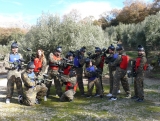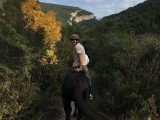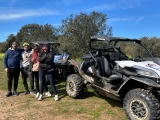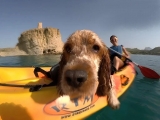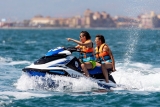A via ferrata is one of the safest experiences in adventure tourism and an ideal way to exercise while connecting with nature. It consists of a horizontal or vertical mountain route that can be undertaken by people without climbing experience thanks to metal rungs and other safety elements. There are many companies offering Via Ferrata in Cantabria, so we recommend using their services if you're inexperienced.
The first via ferratas were built in Austria in the mid-19th century and became particularly important during World War I. After their military use was abandoned, they remained as recreational features. In Spain, the first via ferratas were installed in the late 20th century in Ordesa and Monte Perdido.

When doing a via ferrata, certain safety measures are essential. Although the routes are well-marked and equipped with safety features, a fall could still cause serious injury.
Throughout the route, you're attached to a steel cable (known as the Lifeline) that can withstand weights exceeding 3 tonnes. You should also be equipped with a helmet, harness and shock absorber (in case of falling rocks), proper gloves to protect your hands, and appropriate footwear - comfortable but with thick anti-slip soles. Of course, you'll need a rope in case any rappelling is required.
- For more information, see:
LA HERMIDA VIA FERRATA
- Difficulty: K3-K4
- GPS Position: 43.251902, -4.607492
- Total length: 5.5 km
- Duration: 2 hours
- Elevation gain: 800 m
- Distance from: 13 km from Panes, 18 km from Potes, 26 km from San Vicente de la Barquera
It's located on the N-621 road near Balneario de la Hermida.
From the reception area to the start of the via ferrata, there's a 15-minute walking path leading to the first wall. The initial sections up to Cueva Jabalí are very straightforward, suitable for beginners. They feature numerous rungs, and during the first two sections the wall becomes less vertical as you progress. After a short marked route equipped with a lifeline, you reach a third section that's somewhat more challenging than the previous ones due to its verticality, but progress remains secure thanks to excellent equipment.

Upon reaching Cueva Jabalí, the difficulty increases with a short but very vertical wall and the Rampa Carla Garrido, which requires greater physical preparation: the rungs are further apart, the positions are relatively uncomfortable, etc. From here you have two options: "Cueva Ciloña" and "Los Puentes". If it's not crowded, you can do an out-and-back route via the bridges and continue to Cueva Ciloña. If it's busy, you'll make others wait for you, so this isn't recommended.
The Cueva Ciloña variant is more of a trekking route with a lifeline and some short wall sections with good equipment at the start, rather than a proper via ferrata.
The bridges variant is perhaps the most spectacular, featuring a Tibetan bridge over 35 metres long with drops exceeding 50 metres, and a 100-metre-long hanging bridge with wooden planks.
This via ferrata is ideal for those wanting to experience the feeling of being a rock climber in an incomparable natural setting. While access is free and equipment rental may cost around €20, if it's your first time we recommend booking one of our guided via ferrata experiences to ensure your safety and provide supervision throughout.





